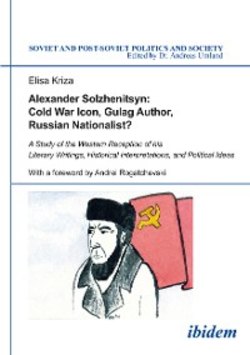Читать книгу Alexander Solzhenitsyn: Cold War Icon, Gulag Author, Russian Nationalist? - Elisa Kriza - Страница 5
ОглавлениеA SALAMANDER IN PERMAFROST?
Without Solzhenitsyn the world would hardly have been the same—but does the changing world still need him? As Elisa Kriza’s book demonstrates, the answer often depends on where and who you are and which part of the author’s legacy you prefer to focus on.
In Russia, Solzhenitsyn’s works defeated the Soviet ban, have (re-)entered the school curriculum and are being staged and televised. His Dictionary of Linguistic Expansion (1990)—a quixotic attempt to save underused Russian vocabulary from oblivion—has recently gone into a third edition. The Customs Union of Belarus, Kazakhstan, and Russia, in operation since 2010, can be seen as a partial implementation of Solzhenitsyn’s 1990 manifesto Rebuilding Russia, which advocated fostering ties between Russia, Belarus, and Ukraine; and suggestively noted the share of Southern Siberia and the Ural Mountains in what Kazakhstan consists of. His film scripts about a Soviet car mechanic (The Parasite, 1968) and the Kengir uprising (Tanks Know the Truth, 1959) are perhaps the only substantial pieces that remain unwanted, possibly because of their high production costs.
As far as the West is concerned, with communism in retreat, Solzhenitsyn is no longer a household name as one of the doctrine’s most iconic detractors and victims. The general decline of the readership in our increasingly visual age is probably affecting Solzhenitsyn more than other authors, because the average length of his books appears prohibitive even to those appreciably intrigued by his controversial (or maybe misunderstood) views on Nazism, homosexuality, Western democracy, and the role of Jews in Russian history (all of which are discussed in Kriza’s study). Anybody who has read Solzhenitsyn’s unfinished Red Wheel epic, about World War I and the Russian Revolutions of 1917—in its entirety, in ten volumes, up to 800 pages each—may well deserve a monument.
Of Solzhenitsyn’s relatively shorter fiction, his 1962 novella about Soviet labour camp experience in the early 1950s, One Day in the Life of Ivan Denisovich (his arguably best known and most impactful title), is frequently perceived to be of purely historical significance, while his novel Cancer Ward (1967) is likely to gain following among cancer patients and their friends and relatives, given that the number of cancer cases across the globe, now at approximately 14 million annually, is expected to rise twofold over the next two decades. Solzhenitsyn’s memoirs about his life in the West, The Grain and the Millstones (1998-2003; a sequel to the 1975 USSR-based The Oak and the Calf), are bound to cause quite a stir when they are translated into English—but they have not yet appeared as a separate edition even in Russia, although more than ten years have passed since the last instalment in their serialization (the delay may have been caused by some potentially litigious content).
According to Kriza, Western academia may have a role to play in helping Solzhenitsyn retain some form of public interest beyond Russia, especially if his reception is regularly mediated by recourse to various literary theories (as opposed to judgements dictated largely by political stances and affiliations). All in all, it is not easy to speculate if Solzhenitsyn’s Western reputation as a credible artist-cum-prophet would rebound any time soon, or, to use his own image from the preface to The Gulag Archipelago, his ideas would stay well preserved, like a salamander in permafrost, hoping to impress distant future generations. Meanwhile, in 2012, as a testimony to Solzhenitsyn’s lasting relevance, the Council of Paris voted (against the objections from the Left) to name a city square in his honour. This may or may not be an encouraging sign.
Andrei Rogatchevski
Professor of Russian Literature and Culture
University of Tromsø, Norway
